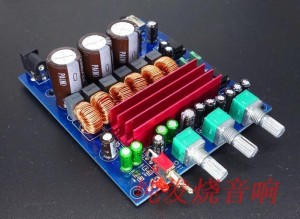
Powering my OS’es and sub, I’ve got a super cheap, eBay sourced, TPA3116 2.1 channel 2x50Watt amplifier board. It’s cool looking, has more than enough power, requires just a bit of soldering to get up and running, and again, super cheap. It’s also the board that comes in many “finished” cheap amps.
The one problem with this amp is that it is really only useable when the 2.0 volume and master volume are at max. If either of these knobs is say at half, there is a fairly loud hiss. When music is playing it is not so noticeable, but quite audible during silences. Last night, trolling youtube, I noticed that not only has this been noticed before, but apparently, there is a fix. Check it out:
The fix comes in two parts:
1. The two potentiometers (the 2.0 and master volume knobs) are the main offenders. Replace them with 10K logarithmic or audio taper pots (they are 50K). You can see the new pots in the thumbnail for the video.
2. The other part of the fix I’m not sure I totally understand, and it looks harder to actually do but it involves changing some of the resistors. Basically, since there are two TPA3116 chips, one should be wired to be the master and the other the slave, but they are both wired as masters in this design. His suggestions fix this, but it involves removing the heat sink, and soldering on the tiny surface mount resistors and, I think, the tiny leads that go to the TPA3116 itself.
FFcossag has a bunch of other relevant videos too, and actually understands electronics. I’m going to enjoy checking them all out.
I wonder if other TPA3116 2.1 designs make the same mistake. I also wonder how many problems might be caused by having pots of the wrong resistance. I noticed the ones that come on many of these cheap amps are 50K, but have read many forum posts where much smaller resistances are recommended, but not a lot of help in learning why. I hope waiting out there is a general rule of thumb for making sense of this without needing to fully understand the circuit diagram and compute relevant values for each individual amplifier design.
